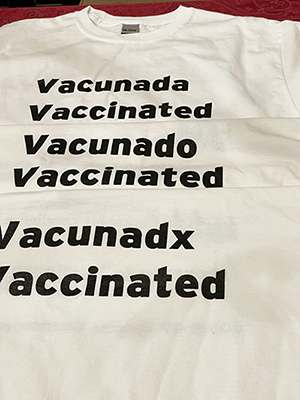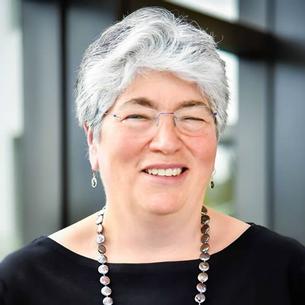
VACUNDA? VACUNDO? VACUNDX?
AUCD Efforts with the National COVID-19 Resiliency Network (NCRN)
01/31/2022

|
| A close up of three folded white tshirts layered vertically on top of each other. The top one reads Vacunada Vaccinated. The middle one reads Vacunado Vaccinated. The bottom one reads Vacunadx Vaccinated. |
Working with developmental disability partners to promote vaccine confidence in the District of Columbia has been a central element of the Georgetown University Center for Excellence in Developmental Disabilities' (Georgetown UCEDD) efforts to fight against the disproportionate and devastating impact of COVID-19 on people with disabilities in DC. DC’s Developmental Disability Council (DD Council) and DC’s Department on Disability Services partnered again this year to host the third annual Latinx Conference. During the conference, the DD Council invited Mary’s Center, a community- based health center, to host a COVID-19 vaccine clinic. The Georgetown UCEDD volunteered to create t- shirts as a vaccine incentive.
It was clear that the t-shirts should celebrate vaccination in both Spanish and English. In English, everyone who receives a vaccine is “vaccinated.” In Spanish, however, men are “vacunado,” and women are “vacunada.” And, what about people who don’t identify as male or female? In recent years, the term Latinx has come into play as a gender-neutral or non-binary alternative to Latino and Latina. According to a 2020 study by the Pew Research Center, only 3% of Hispanics use the term Latinx, but indicators show awareness and use of the term increasing.1
The Georgetown UCEDD vaccine confidence team had a lengthy discussion about the t-shirt design before arriving at a consensus. The team discussed the increasing use of Latinx by young Hispanics and weighed the criticisms of the term. Some critics say the term Latinx is not respectful of the Spanish language and culture. The term, according to critics, was originated by English speakers and fails to recognize and respect the essential, gendered elements of the Spanish language.2
In English, consistent with our mission and values, the Georgetown UCEDD is committed to using each person’s preferred pronouns. In Spanish, the team decided to also recognize preferred adjectives. While it took a little more work and cost a little more money, three sets of t-shirts were delivered for the pop- up clinic at the Latinx Conference – Vacunada/Vaccinated; Vacunado/Vaccinated; Vacunadx/Vaccinated.
The back of the shirt had a description of the project in Spanish and in English: Proyecto de Confianza en la Vacuna. Vaccine Confidence Project.
Language choices must be carefully made in order to appeal to the intended audience in a way that is respectful. People with disabilities carry multiple identities, and products and messages for them should be culturally and linguistically competent.
 Author:
Author:
Robin Shaffert, JD
Senior Policy Associate
Center for Excellence in Developmental Disabilities
Georgetown University
December 2021
1 https://www.pewresearch.org/hispanic/2020/08/11/about-one-in-four-u-s-hispanics-have-heard-of-latinx-but- just-3-use-it/
2 https://www.billboard.com/articles/columns/latin/9514370/latinx-term-latin-community/